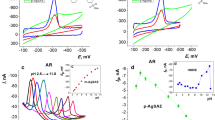Abstract
This article provides an overview of the use of various types of amalgam electrodes for monitoring of organic compounds described in papers published since 2011. Amalgam electrodes are a popular alternative to toxic liquid mercury electrodes in electroanalytical chemistry. These electrodes are made by forming an amalgam between metal and liquid mercury, and offer many advantages, e.g., a wide range of potential windows, low background currents, high sensitivity, and easily surface renewal. This article discusses the different types of amalgam electrodes, including metal solid amalgam electrodes, paste amalgam electrodes, and modifications of amalgam electrodes. The focus is on the use of these electrodes for the determination of organic compounds in environmental, pharmaceutical, food, beverage, and biomedical matrices. The evaluated studies demonstrated that metal solid amalgam electrodes are promising alternatives to the hanging mercury drop electrode for electrochemical measurements.
Graphical abstract

Similar content being viewed by others
References
Kissinger P, Heineman WR (2018) Laboratory Techniques in Electroanalytical Chemistry, revised and expanded. CRC Press, New York
Mikkelsen Ø, Schrøder KH (2003) Electroanalysis 15:679
Nejdl L, Kynicky J, Brtnicky M, Vaculovicova M, Adam V (2017) Sensors 17:1835
Yosypchuk B, Novotný L (2002) Crit Rev Anal Chem 32:141
Yosypchuk B, Barek J (2009) Crit Rev Anal Chem 39:189
Yosypchuk B, Sestaková I (2008) Electroanalysis 20:426
Rapp BE (2013) Electrochemical methods for biomass and biocorrosion monitoring. In: Encyclopedia of Interfacial Chemistry. Elsevier, Amsterdam
Simoska O, Lee YS, Minteer SD (2021) Fundamentals and applications of enzymatic bioelectrocatalysis. In: Comprehensive Inorganic Chemistry III. Elsevier, Amsterdam
Venton BJ, DiScenza D (2021). In: Patel BA (ed) Electrochemistry for Bioanalysis, 1st edn. Elsevier, Oxford
Ozkan SA, Kauffmann JM, Zuman P (2015) Electroanalysis in biomedical and pharmaceutical sciences: voltammetry, amperometry, biosensors, applications. Springer, New York
Maiocco SJ, Walker LM, Elliott SJ (2018) Methods Enzymol 606:319
Deroco PB, de Fátima Giarola J, Júnior D, Lorga GA, Kubota LT (2020) Paper-based electrochemical sensing devices. In: Comprehensive analytical chemistry, vol 89. Elsevier, Amsterdam
Honeychurch K (2012) Printed thick-film biosensors. In: Prudenziati M, Hormadaly J (eds) Printed films. Woodhead Publishing, Sawston
Abollino O, Giacomino A, Malandrino M (2019) Stripping voltammetry. In: Encyclopedia of analytical science, 3rd edn, vol 10. Elsevier, Amsterdam
Danhel A, Yosypchuk B, Vyskocil V, Zima J, Barek J (2011) J Electroanal Chem 656:218
Danhel A, Raindlova V, Havran L, Barek J, Hocek M, Fojta M (2014) Electrochim Acta 129:348
Deylova D, Yosypchuk B, Vyskocil V, Barek J (2011) Electroanalysis 23:1548
Selesovska R, Bandzuchova L, Navratil T, Chylkova J (2012) Electrochim Acta 60:375
Deylova D, Vyskocil V, Barek J, Economou A (2012) Talanta 102:68
Deylova D, Vyskocil V, Barek J (2012) Electrochim Acta 62:335
Lucca BG, Petroni JM, Ferreira VS (2018) Int J Environ Anal Chem 98:859
Sebest P, Fojt L, Ostatna V, Fojta M, Danhel A (2020) Bioelectrochemistry 132:107436
Selesovská R, Martinková P, Stepankova M, Navratil T, Chylkova J (2017) J Anal Methods Chem 2017:3627428
Skrzypek S, Smarzewska S, Ciesielski W (2012) Electroanalysis 24:1153
Vyskocil V, Navratil Dedik J, Danhel A, Dedik J, Krejcova Z, Skvorova L, Tvrdikova J, Barek J (2011) Electroanalysis 23:129
Acknowledgements
The minireview was prepared in the framework of UNIGOU REMOTE ACADEMIC INTERNSHIPS 2023 project of Institute of Czech-Brazilian Academic Cooperation; see https://www.incbac.org. Intellectual, material, and technical support of Metrohm.CZ (https://www.metrohm.com/cs_cz.html) is greatly appreciated.
Author information
Authors and Affiliations
Corresponding author
Additional information
Publisher's Note
Springer Nature remains neutral with regard to jurisdictional claims in published maps and institutional affiliations.
Rights and permissions
Springer Nature or its licensor (e.g. a society or other partner) holds exclusive rights to this article under a publishing agreement with the author(s) or other rightsholder(s); author self-archiving of the accepted manuscript version of this article is solely governed by the terms of such publishing agreement and applicable law.
About this article
Cite this article
Barek, J., Marques, F. The use of amalgam electrodes for monitoring of organic compounds: overview of papers published from 2011 to 2023. Monatsh Chem 154, 949–955 (2023). https://doi.org/10.1007/s00706-023-03107-x
Received:
Accepted:
Published:
Issue Date:
DOI: https://doi.org/10.1007/s00706-023-03107-x




